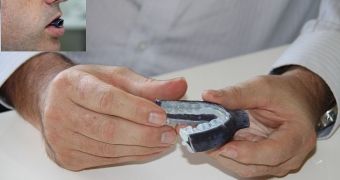Sleep apnea, where you suffer from breathing pauses of 10 seconds to several minutes while asleep, affects about 1 in every 15 people. It's one of those ailments you can have but not know about. Fortunately, medics do know about it, and are always coming up with ways to deal with it.
The latest attempt to deal with the problem might also be the most likely to succeed. It involves the use of 3D printing technology.
Australian company Oventus and the Commonwealth Scientific and Industrial Research Organization (CSIRO) have invented a new device that will let you breathe properly at night.
The deal is this: you go to your dentist’s and have him take a CT scan of your mouth cavity. The scan is then used to create an item that will prevent sleep apnea from damaging your body further.
You see, because the throat collapses during sleep and causes breathing irregularities, sleep apnea can lead to diabetes, high blood pressure and even cardiac arrest.
So what does the invention consist of, exactly? Basically, it provides a new front airway, which lets the air reach the trachea no matter the obstacles (tongue, lower jaw and/or blocked nose).
About 1 million Australians suffer from sleep apnea, CSIRO and Oventus estimate, and the growing frequency of obesity isn't helping matters.
Thus, the new device is bound to have a big and stable market for quite a while. It is made of a “duckbill” that looks like a whistle, sort of.
The bill extends into a pair of separate airways, letting air glow through the back of the throat, avoiding obstacles, as we said.
And since some people suffer from the blocked throat for hundreds of times each night, ignoring the symptoms is not a good idea.
Other solutions for sleep apnea include a face mask that creates a constant flow of air, and devices that push the lower jaw forward.
The new device from Oventus and CSIRO is supposedly better because it is specifically tailored to each user's mouth. And since 3D printing is pretty cheap compared to normal casting and prosthesis making, it should be affordable to everyone who needs one.
“This new device is tailored to an individual’s mouth using a 3D scan and is used only on the top teeth which make it more compact and far more comfortable,” explained Mr. Anderson. “The new 3D printed mouthpiece bypasses all obstructions by having airways that deliver air to the back of the throat and it will also stop patients from snoring.”

 14 DAY TRIAL //
14 DAY TRIAL // 